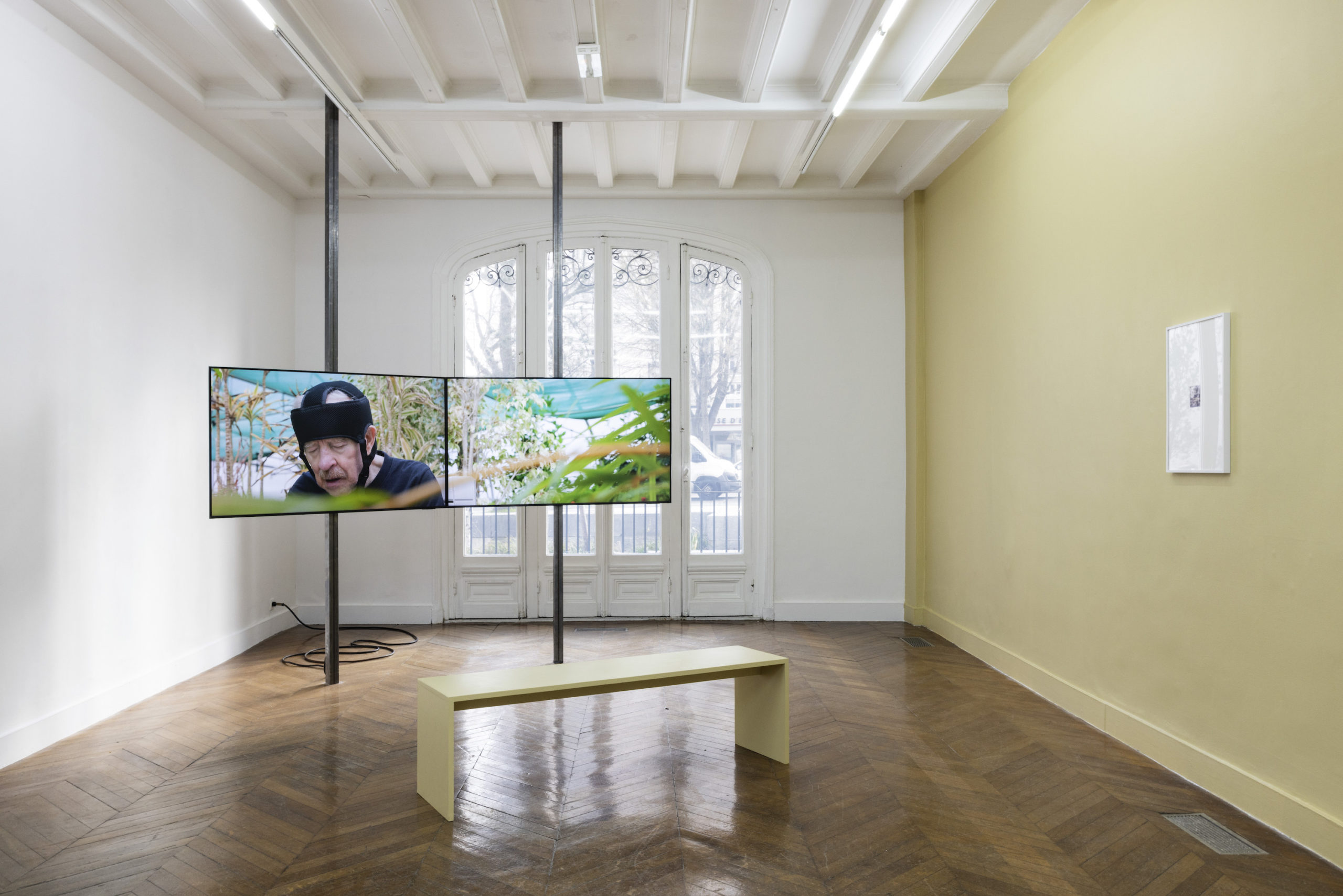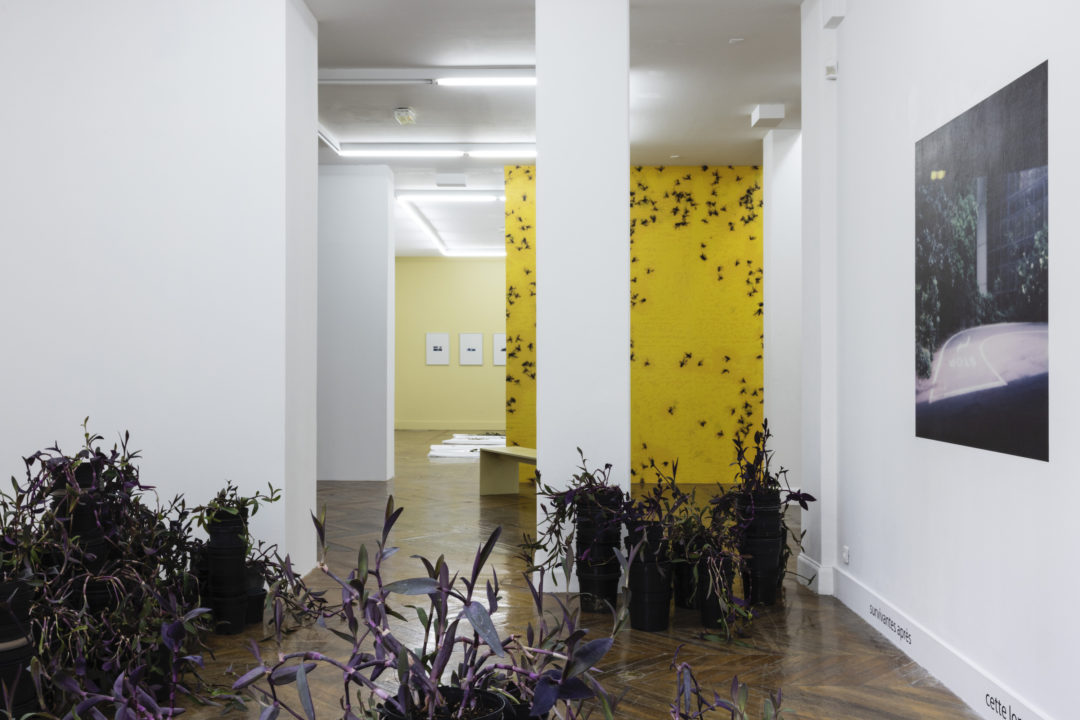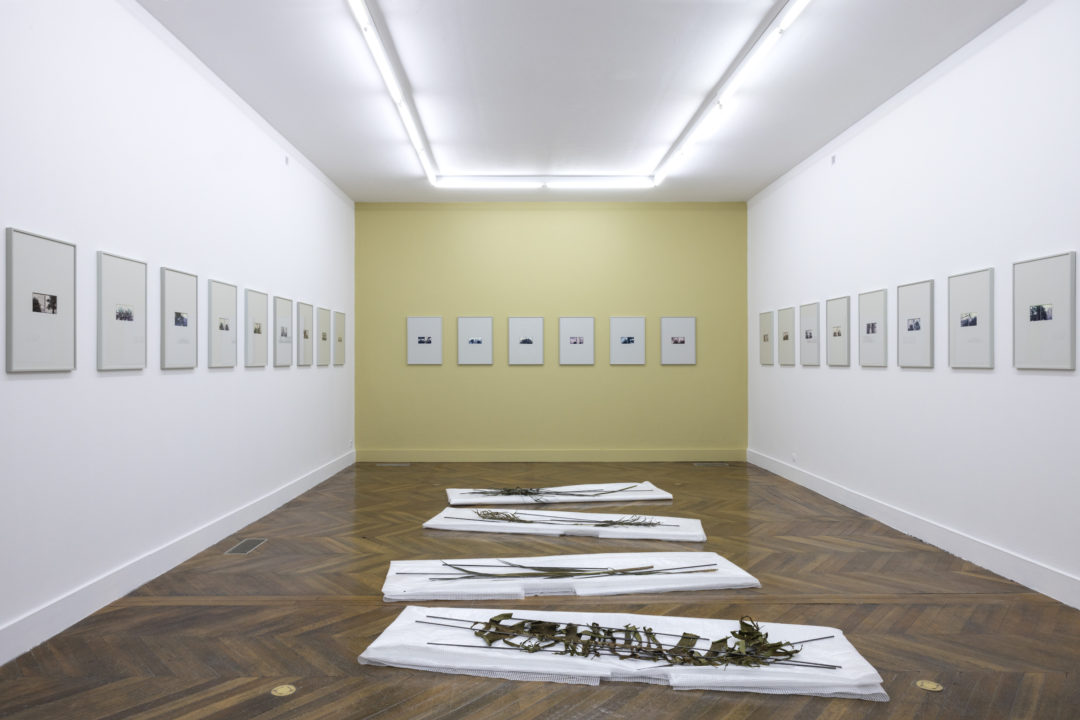Marie Ouazzani and Nicolas Carrier at Centre d’art contemporain de Noisy-le-Sec

Marie Ouazzani and Nicolas Carrier – “Sol Fictions”
at la Galerie, Centre d’art contemporain de Noisy-le-Sec
Exhibition from February 4th to May 27th 2023
Curator : Marc Bembekoff
synecdoche | sɪˈnɛkdəki | noun – a figure of speech in which a part is made to represent the whole or vice versa
The work of Ouazzani Carrier closely applies to the above. Their practice can be perceived as a continuous mass of ever-growing and ever-developing ideas.
Every exhibition, every film, is part of a larger accumulation, which can be perceived as self-sufficient, as well as representing the main body. Nonetheless, no show is ever the same. Elements evolve, switch and are sometimes left behind, while others persist.
At Sol Fictions at La Galerie, Centre d’art contemporain de Noisy-le-Sec the couple is using their habitual pieces: plant infusions, dried plants, polaroids, films as well as an installation of purple hearts. Chosen for their poetic folk name – misère pourpre or purple misery in French, the Tradescantia pallida is a species of extremely resistant plants, originally from Mexico, able to survive extreme conditions of lack of water or light. These plants, which the artists have priorly grown themselves as part of their artistic practice, continue to propagate and expand during the time of the exhibition. Not only is their fast-growing pace continuously changing the visual aspect of the exhibition, it is their resilience that stands as a metaphor for a way of hanging on to life and inhabiting the planet.

©ADAGP, Paris, 2023
Oftentimes, the work of Ouazzani Carrier delves into the exploration of plant species that are not native to Europe but have become commonplace in the present day: palm trees, banana trees etc. In ways known and unknown, these plants have traveled from faraway places, originating mostly to what used to be French and/or European colonies. Reaching the old continent, they created a new life and are thriving in a new environment, adapting and integrating into their surroundings. In an intriguing twist, the artists approach the subject of migration and colonization by examining the journeys of plants rather than humans. By tracing the colonization paths of major European powers, the artists construct a unique and inverted map that represents the movement of these plants.
As a negative space, a parallel mirror to the trajectory that the colonists were doing outwards into the new world, these plants were using the same routes to come to colonize the old world. The presence of these plants acts today as a poignant reminder and physical evidence of the colonizers’ intrusive impact, even in the context of the independence granted to certain colonized nations in unfair conditions. While France may have withdrawn from its former colonies, the colonies continue to leave an indelible mark on France.
From a different perspective, these plants can be seen as precursors to the trajectory of the reversal of human migration which followed. Descendants of the colonized have later found their way back onto European land, often escaping the grim financial situations that their countries were inflicted upon. They would leave their homes looking for a better future, building and enlarging the old world capitals, carving within a place for themselves.
France has the particularity of being a very centralized country, all roads eventually lead to Paris. And Paris is, in this regard, a synecdoche of France. This centralisation, in both cases comes at the cost of a contradiction : the central element will attract yet not entirely accept outer elements – a solar system of sorts. As a nucleus, it retains its own identity and does not allow a homogenous mix. Paris as the capital, doesn’t mix with the province, and Paris as a city doesn’t mix with its suburbs. The French suburbs are a very particular phenomenon, for they are indispensable for the functioning of the city, yet they do not merge with it. The etymology itself of the word suburb in French, “banlieue” is a combination of ban from banni / banished and lieu – place.

It is said that the suburbs of the French cities were constructed by and for the immigrants who came to build the cities. It is in these suburbs, and Noisy-le-Sec is a good example, that we find today our tropical plants growing in the planned gardens, often surrounding brutalist and socialist high rises, destined for low income households and social housing, many inhabited by an immigrant population. These plants are witnesses of the past but also of the present. Despite their fragility, they also represent the resilience of nature, as well as its inevitable perpetuity. In the exhibition, a room is dedicated to this metaphor. The work Éclisses representing dried palm trees placed on plastic tarpaulin and held down with metal rods, is surrounded by polaroid diptychs hanging on the wall showing palm trees growing in the gardens of residential constructions built in the 1960-70 on the outskirts of Paris.
Ouazzani Carrier specifically choose the French suburbs as a subject for their work, photographing and filming landscapes that could be dystopian but which are in fact takes of reality. What is utopian or dystopian if not a perspective on reality? Reminiscing of a post-apocalyptic world, the duo subtitle their films with loosely transformed scientific facts about a variety of chemical elements which are found in our soil and air. Through a poetic apprehension of human involvement in climate change, they play with prospective temporalities, conceiving a potential post-apocalyptic yet not entirely bleak future.
In a semi-anthropomorphic manner, the plants are acting as decor as well as simultaneously play the main characters of their fiction films. The film shown in the exhibition, Millieu Vague, played on four screens, depicts static cameras pointed in one direction and portrays food plants – aubergines, tomatoes, kale – growing outside in the air versus scenes of greenhouse-grown plants and mushrooms surrounded by sticky insect traps and chains. In a deeply symbolic yet unpretentious decision, the plant scenes are combined with sequences portraying a tired, elderly man wearing a protective medical helmet, as well as a dog, roaming free in a wasteland. In the spirit of slow cinema, the artists let the images speak for themselves with minimal involvement in the form of film editing. The long takes allow both the artists and the viewers to contemplate a scene and find their own reading of the content.
Ouazzani Carrier’s work emphasizes the complex dynamics of migration, colonization, and the enduring presence of the colonizer through the lens of plant journeys, offering a stimulating perspective not only on the intertwined histories of Europe and its colonies, but also on that of the human species colonizing nature. Through thoughtful, poetic, and at times uncanny scenes, the visitor is absorbed in a world of almost tomorrow. And even though the future is terrifying, we are not there just yet.
______________________________________________________________________________
Head image : Milieu vague, 2022, 2 vidéos 8K sur 4 écrans, 14 min, production La Galerie, centre d’art contemporain de Noisy-le-Sec, Fondation des Artistes ©ADAGP, Paris, 2023
- From the issue: 104
- Share: ,
- By the same author: Streaming from our eyes, Déborah Bron & Camille Sevez, Sanam Khatibi, Ho Tzu Nyen, GESTE Paris,
Related articles
Streaming from our eyes
by Gabriela Anco
Don’t Take It Too Seriously
by Patrice Joly
Déborah Bron & Camille Sevez
by Gabriela Anco

